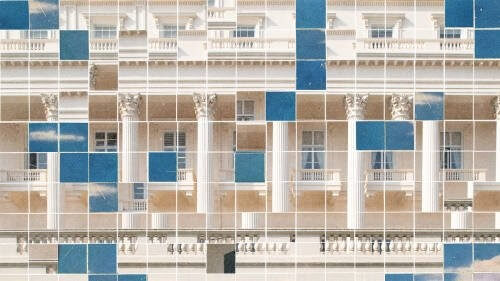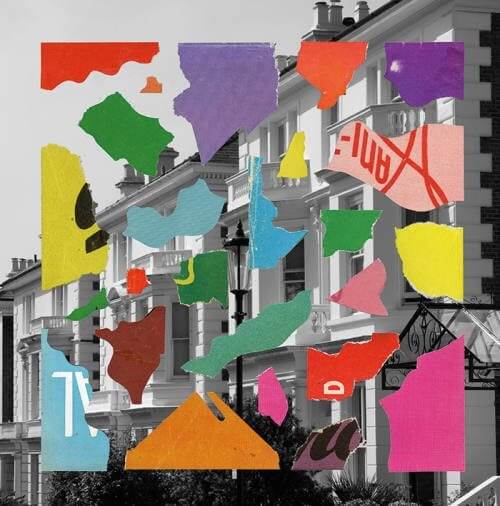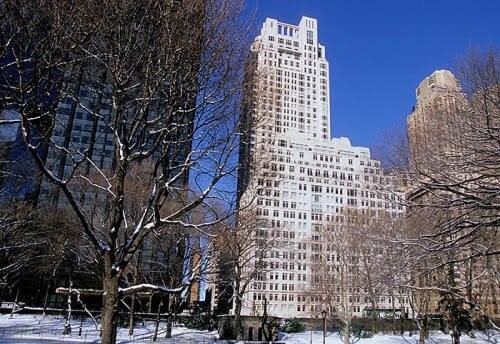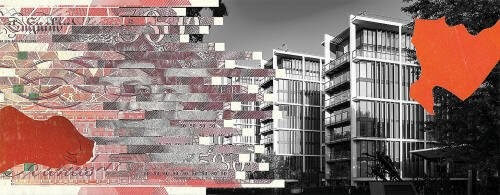By Judith Evans
Luxury homes have morphed into a global currency — a tangible asset with cachet
How much would you pay for a 20,000 sq ft neoclassical mansion close to London’s Buckingham Palace, complete with an underground extension and private formal gardens — not to mention the swimming pool, gym, spa and staff quarters?
Ken Griffin, the billionaire founder of the Chicago-based hedge fund Citadel, settled on £95m. This is the approximate sum for which, earlier this year, he bought 3 Carlton Gardens, a newly restored London home that was the private office of Charles de Gaulle during the second world war.
But that was a steep markdown from the £125m at which the home had been marketed — and even more so from the £145m the developers had originally hoped the reimagined Nash-era mansion would fetch. That £30m price differential is the price of a David Hockney painting, a gold mine in Russia or the League One football club Charlton Athletic.
Such negotiations are becoming increasingly common as the world’s ultra-wealthy increase in numbers and the market for properties aimed at them becomes larger and more international.
Yet the different dynamics in the “super prime” property market mean developers, agents, lenders and buyers can face an extended wrangle to establish the “real” value of a home, in a market where prices run into eight figures and many of the normal metrics — such as rental yields or comparisons with similar homes — often do not apply.
Neal Hudson, founder of the consultancy Residential Analysts, says the value of super-prime residential property is “a bit like the art market: some things are only worth what the next person is willing to pay for it. There’s not an underlying economic value there that it’s rationally based on, like the percentage yield from an office block in the City.”
The world’s ultra-wealthy, those with net assets of more than $30m, increased by 4 per cent in 2018 to almost 200,000 people, according to Knight Frank’s Wealth Report, which predicts their numbers will reach almost 250,000 by the end of 2023.
People in this bracket increasingly own a portfolio of trophy homes in global cities, agents in the sector say. Griffin is a case in point: his £95m London house, and a penthouse apartment in the city he has agreed to buy for about £100m, add to a portfolio of homes in Miami, Palm Beach, Chicago and New York, including Manhattan’s most expensive home, a new-build penthouse bought for $238m.
Jonathan Miller, a New York housing analyst, wrote in a report: “Luxury real estate has morphed into a new world currency that provides investors with both a tangible asset and a cachet that cannot be found within the financial markets.”
Prices for luxury homes are falling in London, New York and more than 20 other cities globally, according to Knight Frank. But discounts on homes costing more than £10m in London are on average less steep than on less expensive “prime” properties, according to figures from LonRes, a data source; agents say buyers in this market can be less sensitive to price movements than those lower down the scale.
“People with very deep pockets see something of value and will pay a lot of money for it still,” said Charles McDowell, a Mayfair estate agent.
Garrett Derderian, director of data at the New York real estate agents Stribling, agrees. “What we’re seeing, especially in the Manhattan market right now, is an increasing disparity between the super-wealthy, those buying homes for $30m or above, and the mere wealthy.
“The super-prime market has diverged from the rest, at least in terms of the numbers of transactions happening even as the wider market is softening.”
The figures may be skewed to an extent by completions of new-build properties where sales were agreed in previous years, he notes. But Derderian believes the market has been bolstered by the scarcity value of the properties billionaires look to acquire, such as those overlooking Manhattan’s green space. “There is only so much Central Park,” he says.
Valuing a home in the mainstream market is made easy by the thousands of transactions of similar homes that take place each year. But assessing the value of a top-end mansion is less straightforward, says Jonathan Harris, director at the London-based mortgage brokers Anderson Harris. “It’s all about comparables, but they are trickier when you are looking at higher values. There tends to be fewer of them and much lower levels of activity; the homes can be quite unique. It can be quite subjective.”
The higher the price, the slimmer the field of comparable properties. “Super-prime” or “ultra-prime” homes start at anywhere from £10m to £30m, depending on which agent you speak to; for homes costing more than £50m, the market “is not so much a market as a handful of anomalies,” says Roarie Scarisbrick, a London buying agent at Property Vision.
Valuers may take into account potential rental yields, but only if a buyer is purchasing with a view to letting out the property (not something Griffin has indicated he will do). More broadly, says Dominic Grace, head of London residential development at Savills: “Yield has never been a driver for super prime buyers.”
Agents who buy and sell homes at the very high end say their market does operate, to some degree, logically. Buyers still pay for size, views and extras, whether it be a 10-car garage, full-sized home cinema or Olympic-sized pool.
Philmore Gardens in London’s Holland Park is one of the city’s most exclusive streets. © Alamy Stock Photo
McDowell says location is crucial to a home holding its price over time. A particular street can underpin value in a way that another road close by does not.
Phillimore Gardens, a street of Georgian villas backing on to west London’s Holland Park, is a “blue-chip” street, McDowell says. A seven-bedroom family house there is currently on sale for £30m. The street’s location between Holland Park and Kensington High Street, its freedom from “rogue traffic” and its unusually large homes for the area all play a part in that appeal, he said — against a backdrop of the street’s position in one of the capital’s most exclusive postcodes.
‘Location is crucial . . . a particular street can underpin value in a way another road nearby does not’. (Charles McDowell, a Mayfair estate agent).
Rarity adds to value: few homes can boast of being less than a kilometre from the Queen’s residence and of previously being used by the UK intelligence service to interview potential recruits, like Griffin’s 3 Carlton Gardens.
Values for high-end homes may be falling now around the globe, but they have increased in recent decades. Knight Frank’s Prime Global Cities Index, an unweighted index of price changes that tracks the most expensive 5 per cent of homes in major cities — less rarefied than the “ultra-prime” market — indicates that the typical value of prime properties being traded has risen 59 per cent across the world since 2006, or about 4.5 per cent a year on average, not taking into account costs associated with ownership.
The figures vary significantly by city, according to separate data from Savills, which says price growth can be fuelled not only by domestic wealth increasing but by a “promotion phase” when a city turns outward to become a global destination.
In 10 years, prices for prime homes in China’s Shenzhen have risen 388 per cent and Beijing 322 per cent, Savills said. In Berlin they have more than doubled, rising 118 per cent, and in San Francisco 80 per cent. London prices rose 41 per cent and New York 40 per cent.
In Manhattan, super-prime homes are dominated by new condominium blocks that have mushroomed since the financial crisis, says Derderian. These now make up the “overwhelming majority” of homes changing hands at the top end.
Residence 14d in 15 Central Park West, Manhattan sold for $29.5m in 2017 © Alamy Stock Photo
The relative newness of these homes makes it difficult to track long-term values, but 15 Central Park West, a complex completed in 2008, gives some indication. Residence 14d in the building sold for $21m in 2007 and then $29.5m, a rise of 39 per cent, almost exactly 10 years later, a rise in value of 3.9 per cent on average each year.
‘Super prime properties hold their values over time if and only if the property is incredibly rare’. (Lauren Muss, associate broker at Douglas Elliman in New York).
For that price, residents get not only an apartment overlooking Central Park replete with marble and chandeliers, but also a private climate-controlled wine room and access to a 14,000 sq ft fitness centre, billiards room, private dining service and movie theatre.
But this price movement excludes costs, which may be substantial. Another luxury apartment in Manhattan, currently being marketed for $57m, is charged monthly taxes of almost $17,600, while common charges, known in the UK as service charges, come to a little more than $15,000 a month: a fairly typical set of costs, says Derderian. That comes to almost $400,000 a year of costs — and that is before the buyer has even hired their domestic staff. Still, that sum amounts to less than 1 per cent of the property’s asking price.
As new homes tailored to the ultra-rich begin to change hands in the secondary market, more evidence will emerge of long-term pricing in this exclusive market. A similar rising trend is evident in One Hyde Park, an ultra-prime block completed in 2009 in London, boasting a 21m ozone swimming pool, golf simulator, private cinema and dozens of dedicated staff from the nearby Mandarin Oriental hotel.
Nick Candy, one of the block’s developers, says there is “increasing demand from wealthy investors and families to own one of the best addresses in the capital”.
He might be expected to say this, but the numbers bear him out so far, says Scarisbrick of Property Vision. Flats on the more desirable side of One Hyde Park, facing the park itself, sold for £4,000 to £5,000 a square foot in 2007 ahead of completion; they are now changing hands for about £7,000 a square foot, he said.
“The better flats in this building, high up and with a better outlook, have definitely outperformed the rest,” says Scarisbrick.
Other transactions show the dizzying effect of cyclical movements. Another apartment in New York’s 15 Central Park West was bought for $11.6m in 2008 then sold for $21.5m, or 85 per cent more, less than two years later, says Derderian.
By mis-timing the cycle, it is equally easy to lose millions. The Russian buyer of one apartment on London’s Chesterfield Gardens bought the home in 2009 for £19m and sold it recently for £13m, according to an agent with knowledge of the sale — a loss of £6m, before taking account of taxes and other costs.
The current cycle has also caught out a series of developers who carried out refurbishments of period properties, only to be forced to sell them as the market slumped, said Camilla Dell, managing partner at Black Brick, a buying agency.
One home on Cresswell Place in London’s Kensington was marketed for £37.5m but sold for 40 per cent less, at £22m, she says. For super-prime property to hold its value over time it needs to be “the right super-prime, without compromise”, she adds. That means “a very long lease or freehold” and “not just the right address, but the right part of the right address”.
For example, ultra-wealthy buyers will seek out a location such as London’s Chester Square because “you can’t buy anything there for less than £10m, so there’s that recognition of an address that means ‘I’ve made it in life’,” says Dell. But the most valuable homes are on the sunny side of the square, away from the traffic. “Homes on the wrong side of the square will never achieve so much,” Dell adds.
Lauren Muss, associate broker at Douglas Elliman in New York, agrees.
“Super-prime properties hold their values over time if and only if the property is incredibly rare and offers buyers a true, once-in-a-lifetime opportunity,” she says. “I have been in this business a long time and have seen people overpay for average townhouses or apartments.”
Griffin may have negotiated hard when buying his London house, but he has not said whether he views it primarily as an investment.
He told the Chicago Tribune four years ago: “When people make a decision to buy a piece of high-end real estate, it’s not just an investment. It’s where they spend time with their family and their loved ones.”



















